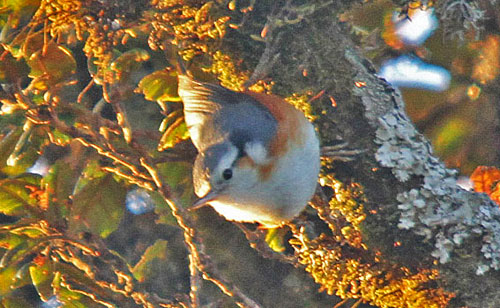
White-browed Nuthatch, a charming Myanmar endemic. Photo: Paul Holt
The wonders of Myanmar have been largely hidden from foreigners for a generation. However it cannot have escaped many people’s notice that things have been changing in this previously remote and intriguing land. Still known to the majority of westerners as Burma, this tour will show you not only some of its wonderful birds, including all six of the nation’s endemics, but also some of its fascinating culture and history.
We’ll visit a number of Myanmar’s diverse and distinctive regions beginning with the glittering pagodas and tree-lined avenues of the charming old-world capital Yangon (formerly Rangoon). We’ll spent time here, adjacent to the huge rice-producing delta of the Irrawaddy River, before flying north to the spectacular ancient capital of Bagan, situated in the lee of the lofty Chin Hills. Besides being a truly amazing historical site, Bagan also harbors a number of special birds such as four endemics; Jerdon’s Minivet, Hooded Treepie, Burmese Bushlark and White-throated Babbler. From here we’ll visit the extensive mixed-deciduous forests that cloak Mt Victoria, Myanmar’s premier National Park, where we’ll spend four full days, and then the scenic Inle Lake and the rich mosaic of marshland and agriculture that surrounds it, before we end in the cooler old colonial hill station of Kalaw. Along the way we’ll encounter numerous interesting birds and some remarkable ancient buildings while also having time to soak up much of typical Myanmar life at a possible turning point in its long history.
Day 1: The tour begins this evening in Yangon.
Day 2: We’ll spend the day exploring parts of this ancient city, including paying a visit to the famous Shwedagon Pagoda topped by a gleaming gold stupa. We’ll return to the hotel later in the day before flying to Bagan, one of the riches archaeological sites in the whole of Southeast Asia. Night in Bagan.
Paul Holt is both a very skilled bird guide and a competent, careful and business-like tour leader. We greatly appreciated both sets of skills. We would be enthusiastic about both WINGS/Sunbird and Paul Holt for additional trips.
Dick and Nancy Eales, March 2015
Days 3-4: Lying on the east bank of the famous Irrawaddy River, Bagan is a wondrous treasure trove comprising of over 4000 pagodas. Nature has done a fine job of reclaiming this historical site with the end result that we’ll find ourselves birding in a magical setting surrounded by ancient buildings and monuments, some more than a thousand years old. While we’ll spend time exploring this magnificent archaeological site, we are in Myanmar’s ‘dry zone’ and a great place to find four of the nation’s endemics birds – Jerdon’s Minivet, Hooded Treepie, Burmese Bushlark and White-throated Babbler. Other target species here will include Rain Quail, Laggar Falcon and Burmese Prinia.
We’ll also search the vast sandbanks of the mighty Irrawaddy River – hunting for some of the region’s specialities such as Sand Lark, Violet-breasted Starling and Plain-backed Sparrow. Other ornithological targets in farmland near to Bagan include Barred Buttonquail, River Lapwing, Small Pratincole, the very distinctive xanthocyclus form of Eurasian Collared Dove, Spotted Owlet, Indian Nightjar, Ayeyarwady Bulbul, Yellow-eyed Babbler, and Long-billed Pipit to name a few. Nights in Bagan.
Day 5: We’ll leave early for the short drive to Chauk where we’ll cross the Irrawaddy River before beginning our journey up in to the Chin Hills. In lowland forest along the way we’ll have another opportunity, should we need it, to search again for the endemic Hooded Treepie and Jerdon’s Minivet as well as other specialities such as Grey-headed and Blossom-headed Parakeets, White-rumped Falcon, White-eyed Buzzard, Green-billed Malkoha, Red Junglefowl, and a variety of woodpeckers including White-bellied, babblers, laughingthrushes, minivets, and orioles.
Our destination will be a simple but comfortable lodge above Kanpetlet, a town in Chin State, the district closest to central Myanmar. Mt. Victoria is known locally by its alternative monikers of Khaw-nu-thone and Nat-ma-taung in Chin and Burmese languages respectively – both translated as “Mother of Spirits.” We’ll spend five nights on Mt. Victoria - all at our lodge above Kanpetlet. Here, at just under 6000 feet on the southeast slope of the mountain, the climate is cool and pleasant.
Days 6-9: We’ll spend four full days birding in the Nat-ma-taung (Mt. Victoria) National Park – an impressive park that covers an area of 179 square miles and is home to a huge variety of birds, including the endemic White-browed Nuthatch and Burmese Bushtit. There is a rich mosaic of habitats here, ranging from mixed oak and rhododendron forest, montane bamboo, pine forest, thick secondary growth with tall grass and scrub, semi-cultivated fields and grasslands and we’ll have plenty to look for. Blyth’s Shrike-babbler, Grey Sibia, Brown-capped, Blue-winged, Assam and Striped Laughingthrushes, Spot-breasted Scimitar Babbler, Spot-breasted Parrotbill, Black-throated Parrotbill and Hodgsons’s Frogmouth are just some of the species we may see.
As with any montane habitat, different elevations support different species. On Mount Victoria Rufous-bellied Woodpecker, Grey sided Thrush, Himalayan Bluetail and even occasionally Black-headed Shrike-babbler, Himalayan Cutia and Vivid Niltava may be seen on our daily morning drives up the mountain. Rare and colorful species such as Fire-tailed and Mrs. Gould’s Sunbirds, Chestnut-tailed and Blue-winged Minlas and Spot-winged Grosbeaks will keep us permanently excited. Nights at a Kanpetlet lodge.
Day 10: Most of the day will be taken up with the drive back to Bagan but there will be numerous stops for any lowland specialties we may have previously missed. Night back in Bagan.
Day 11: We’ll fly from Bagan to Heho and then drive to Inle. Situated at just under 3000 feet on the Shan Plateau, Inle is the second largest lake in Myanmar and famed for its ‘leg rowers.’ After checking in to our hotel, we’ll take a boat ride searching for primarily for the rare and local Jerdon’s Bush Chat. This striking small chat, is relatively easy to see here and we have a good chance of encountering several birds. There is also a very slim chance of finding that most elusive of Asian ducks, Baer’s Pochard. In addition there will be the opportunity to catch up with a variety of waterbirds, including Ferruginous Duck, and Pheasant-tailed Jacana, while islands of emergent vegetation can hold Citrine Wagtail and Rosy Pipit. Groups of Brown headed Gulls may follow the boat while around the lake edge Pied, Western and Eastern Marsh Harriers regularly hunt over the reed-beds where Striated Grassbirds perform their conspicuous bubbling song flight. Other target species will include Chinese Grassbird and Collared Myna. Night in Inle.
Day 12: We’ll drive to Kalaw, an attractive hill station located just over 1300 meters above sea level that still bears many reminders of its 19th century colonial roots. We’ll spend the afternoon searching for a variety of species including Spectacled Barwing and White-browed Laughingthrush. Night at Kalaw.
Day 13: We’ll spend the whole day out on a trail to Yay Aye Kan lake. Here among the surrounding forest we’ll look for Burmese Yuhina, Davison’s Leaf Warbler, Black tailed Crake, Silver-eared Laughingthrush, Dark-backed Sibia, Common Green Magpie, and Pin-tailed Green Pigeon. Night again in Kalaw.
Day 14: We’ll return to Heho airport for a mid-morning flight back to Yangon. Dropping our luggage at our hotel we’ll head back out for lunch and a further look around this fascinating, large city.
Day 15: We’ll leave early for Hlawga Wildlife Park on the outskirts of Yangon where we’ll look for Racket-tailed Treepie, Thick-billed Green Pigeon, Black-naped Oriole, the distinctive ‘white-eyed’ form of Stripe-throated Bulbul (which is only found in South Myanmar) and some of the commoner birds of lowland Myanmar such as Chestnut-headed Bee-eater, Olive-backed Sunbird, and Scarlet-backed Flowerpecker. Neighbouring wetlands might well yield views of Oriental Darter or more Asian Openbills. The tour ends when we return to the hotel to collect our luggage in the late afternoon.
Updated: 11 May 2020
Notes

Questions? Tour Manager: Stephanie Schaefer. Call 1-866-547-9868 (US or Canada) or (01) 520-320-9868 or click here to email.
* Tour invoices paid by check carry a 4% discount. Details here.
Maximum group size eight with two leaders.
